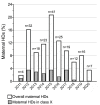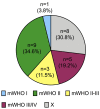Cardiac and obstetric outcomes in pregnant women with heart disease: appraisal of the 2018 mWHO classification
- PMID: 35332050
- PMCID: PMC8948382
- DOI: 10.1136/openhrt-2021-001947
Cardiac and obstetric outcomes in pregnant women with heart disease: appraisal of the 2018 mWHO classification
Abstract
Objective: To appraise the application of the 2018 European Society of Cardiology-adapted modified WHO (mWHO) classification to pregnant women with heart disease managed at our maternal-fetal medicine referral centre and to assess whether the lack of a multidisciplinary Pregnancy Heart team has influenced their outcomes.
Methods: A retrospective cohort study including all pregnancies with heart disease managed at our centre between June 2011 and December 2020. Cardiac conditions were categorised in five classes according to the mWHO classification. An additional class, named X, was created for conditions not included in this classification. Outcomes were compared among all classes and factors potentially associated to cardiac complications were assessed.
Results: We identified 162 women with 197 pregnancies, for a prevalence of 0.7%. Thirty-eight (19.3%) gestations were included in class X. Caesarean section was performed in 64.9% pregnancies in class X, a rate similar to that of class II, II-III, and III/IV, and mostly for obstetric indications; in turn, it was more commonly performed for cardiology reasons in class II-III and III/IV. Cardiac complications occurred in 10.7%, with class X and II pregnancies showing the highest number of events (n=30.8% and 34.6%, respectively). Multiple gestation and urgent caesarean section associated with a 5-fold and 6.5-fold increase in complication rates.
Conclusions: Even in a maternal-fetal medicine referral centre, the lack of a multidisciplinary team approach to women with heart disease may negatively impact their outcomes.
Keywords: heart failure; metabolic syndrome; pregnancy; stroke.
© Author(s) (or their employer(s)) 2022. Re-use permitted under CC BY-NC. No commercial re-use. See rights and permissions. Published by BMJ.
Conflict of interest statement
Competing interests: None declared.
Figures



References
-
- Knight M, Bunch K, Tuffnell D. MBRRACE-UK. Saving Lives, Improving Mothers’ Care. In: Lessons learned to inform maternity care from the UK and ireland Confidential enquiries into maternal deaths and morbidity, 2020: 2016–8.
MeSH terms
LinkOut - more resources
Full Text Sources
Medical
